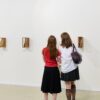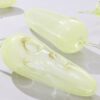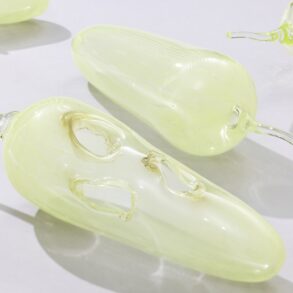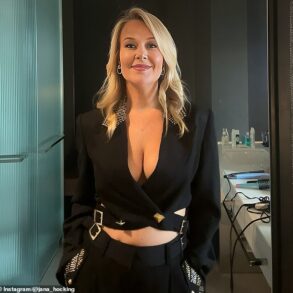COLORADO SPRINGS — Not everyone loves the look of a new permanent exhibition at the Colorado Springs Pioneers Museum.
“Some people walk in and are just horrified. They want 18-to-24 inch spaces between the artwork,” said Leah Davis Witherow, curator of history for the museum. They complain to her that there isn’t enough information on the walls.
The museum’s latest exhibition, “50% of the Story: Women Expressing Creativity” is displayed salon style, its works hung in clusters, with no dates and minimal wall text.
“It’s a little ‘hit you over the head,’ but that’s the way we wanted it to be,” she said.
Davis Witherow has been dreaming up this exhibition for years as a response to the dismally underrepresented number of women in the permanent collections of museums around the country.
In 2022 the Burns Halperin report surveyed 31 major art museums, including the top 10 most visited museums in the country. The report found that only 11% of all acquisitions made between 2008 and 2020 were of female-identifying artists, and those artists were shown in only 15% of exhibitions.
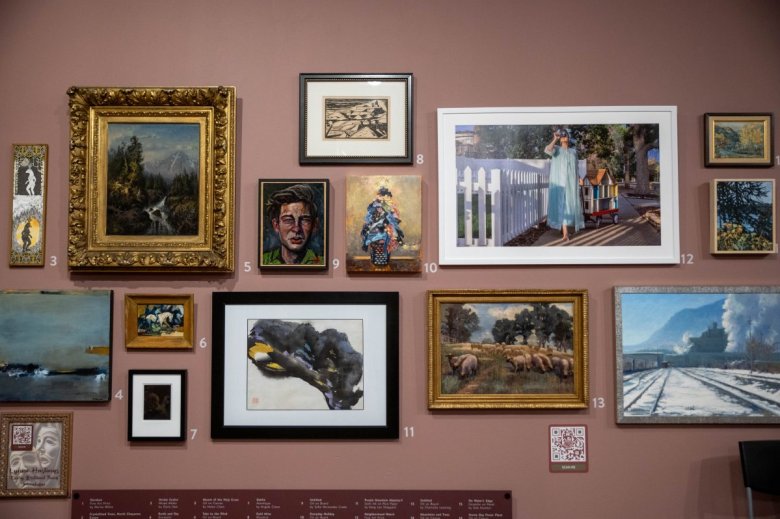
Since it opened in 1896, the Pioneers Museum has collected about 2,000 works, 10% of which are attributed to women. So far, because of the new exhibition, the museum has acquired 88 contemporary works by women connected to the Pikes Peak region, bumping that percentage up to 15%. But it is an ongoing project, and an expensive one. The museum has spent almost $50,000 over the past year acquiring work by local female artists, and a recent $100,000 donation by the Lane Foundation will help them continue the effort.
A majority of pieces are paintings, though the collection also includes photography, quilts, embroidery, sculpture, botanical drawings, a monologue, a poem, a dance piece and a hair wreath — a wreath made of human hair — from 1840.
11% and counting
It’s not just a museum issue. The total size of the international art auction market from 2008 to mid-2022 was $187 billion, according to the Burns Halperin report. Of that, only $6.2 billion was spent on works of art by women, or just over 3% of works sold. For perspective, the report noted that works by Pablo Picasso alone generated $6.23 billion over that same time period. And Artnet’s annual art market report showed that last year 11 women cracked the 100 top-selling artists at auctions — tied with 2022 for the highest number of women recorded.
Auctions aren’t reliable representations of art in society, though. Instead, they tend to reflect the slowly shifting tastes of a minority of art collectors.
At the same time, auction prices do provide context for museum collections. Those collections, along with scholarly analysis, can lend credibility to overlooked artists. So being part of a museum’s permanent collection can help boost auction prices, while high auction prices grab a museum’s attention.
As far as exhibitions go, the Burns Halperin report found that about 15% of exhibitions between 2008 and 2022 featured female artists, some of which have left a big impression: see Bisa Butler’s vibrant, quilted portraits at the Art Institute of Chicago; or Barbara Kreuger’s massive, touring exhibition; or the global triennial at the National Museum of Women in the Arts, in Washington, D.C.
But Davis Witherow believes the Pioneers Museum is one of the only places in the country right now with a permanent all-female exhibition. For most major solo shows or retrospectives, institutions borrow the works from other museums or private collectors, to be returned once the exhibition ends.
“People need to know that it’s not a one and done. They need to know they can come back again and again, and see these stories told over and over,” Davis Witherow said.
Though widely cited, the Burns Halperin report has also received criticism.
An article by Terence Washington in Artnet, which provided data and backing for the report, argued that matching collections to democratic data is insufficient, and doesn’t treat the underlying structures in museums that cause inequities. Washington’s recommendation was to look to the workers — especially those involved in union activity — to understand a museum’s internal dynamics.
Others have questioned the report’s definition of artists, noting that it doesn’t align with the U.S. Census’ classification of working artists, and have pushed back against the exclusion of artists who do not make art for commercial distribution.
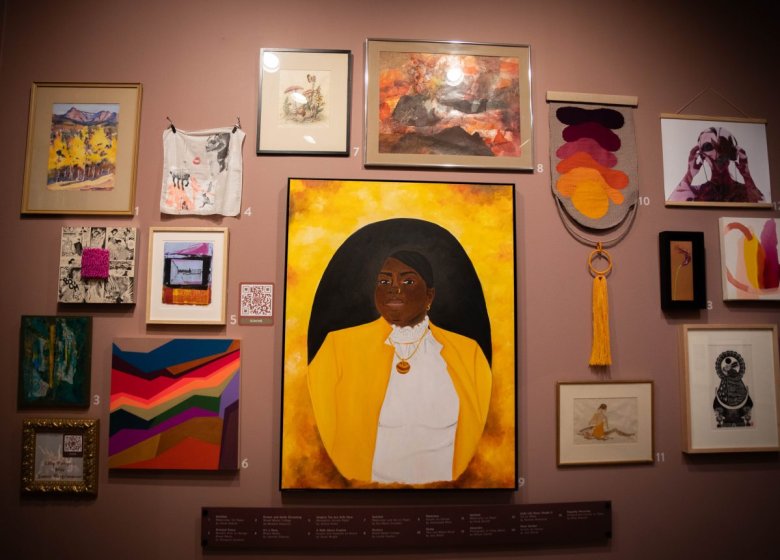
But for Davis Witherow, the gallery and its makeover are inextricable from the museum’s mission.
“Our job is to be a mirror to our community,” Davis Witherow said. “No matter if you’ve lived here five years, 50 years or five months, you come into the museum and you see a little bit of your story reflected. In this gallery, you should see someone that looks like you. That is critically important.”
Arts are crafts
Hanging on one of the gallery walls is an intricate embroidery of the Pikes Peak region created by Claudia Lee (Yates) Bernd. Bernd made it to celebrate the state’s centennial in 1976, but it took her five years to complete, Davis Witherow laughed.
“People are having a hard time keeping their hands off of it,” she added, then turned and gestured to a quilt encased in plexiglass on the opposite wall.
“Of course, it’s a textile, it’s so tactile. People who don’t think of a quilt as a work of art, they think of it as craft, and they think it’s inherently touchable, that it’s not something to be cautious about like an oil painting. So we’re having to reinforce museum behavior,” she said, pointing at stickers on the ground that encourage a buffer between the viewer and the wall. “We’re trying to be gentle, give gentle reminders about how to examine art without damaging it.”
Most of the oldest artifacts are protected by some kind of case, but so are some of the newest works. Davis Witherow doesn’t want people to get caught up on when a work was made — if they are especially interested, they can scan a QR code on the wall, or find the artwork on the museum’s website.
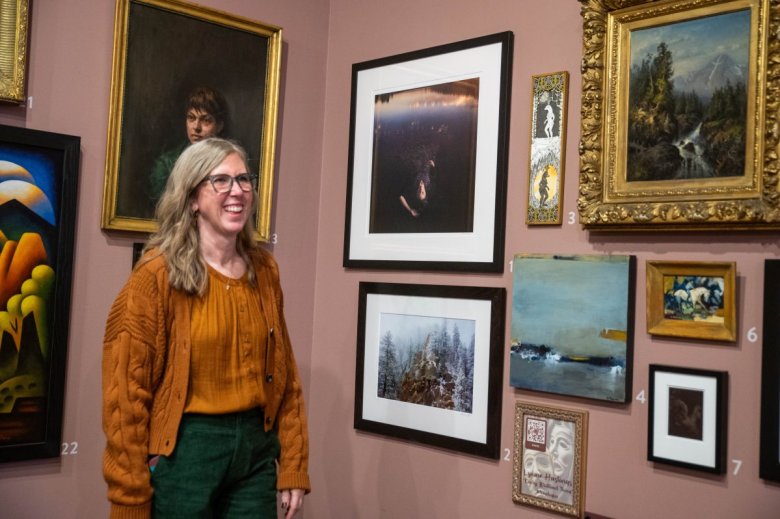
Some of the works play with the exhibition’s ahistorical bent, like Lindsay Hand’s “Motherling,” a stunning, dark portrait of Mary Lincoln “Queen” Palmer, which mimics a historical portraiture style and looks like something that the museum would have dug out of its archives. But the wife of Colorado Springs founder Gen. William Jackson Palmer never had her portrait painted during her time in Colorado Springs, Davis Witherow said. The museum commissioned the portrait from Hand for the exhibition.
Across the gallery, “Illustrious,” a self-portrait by Jeresneyka Rose shows the artist framed by a golden vignette, her shoulders are back and chin is tilted slightly up and right, in the way of a general or a former president. These nods to historical portraiture are there to remind the viewer of everything that hasn’t been collected by history and cultural museums throughout the state, until now. And there is still room on the walls for more.
“It doesn’t mean that we are going to stop collecting male artists,” Davis Witherow said. “But when an institution like ours, or any other museum, has collected primarily men for 125-plus years, I think we can confidently collect from these artists for decades to come, and we’re not going to reach saturation.”
The Pioneers Museum is open Tuesday-Saturday, 10 a.m.-5 p.m. Admission is free.
This post was originally published on this site be sure to check out more of their content

